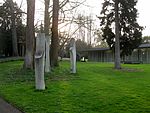Paul Dierkes
Paul Dierkes (born August 4, 1907 in Cloppenburg , † March 25, 1968 in Berlin ) was a German sculptor and graphic artist .
Life
Born as the son of the Cloppenburg stonemason Clemens Dierkes (1866-1932), he first completed a craft training in Telgte and a traveling apprenticeship until 1929. He then studied at the Königsberg Art Academy in the sculpture class of Stanislaus Cauer , moved to Munich in 1931 and received in the same year a scholarship for Rome . He then settled in Berlin, which became his artistic home and which he regarded as the “real German sculptor center” (Dr. Jürgen Weichardt , art critic). In 1935, at the same time as Hermann Blumenthal, he received a scholarship in Kassel . In 1936 he had his first solo exhibition in the Ferdinand Möller gallery in Berlin , and in 1937 in the Augusteum in Oldenburg . He later visited other European art centers, demonstrably Amsterdam , Prague and Paris . During the National Socialist rule , he left Berlin and, thanks to influential friends, was repeatedly able to avoid being drafted into the Wehrmacht . Shortly after the end of the war (1945) he first returned to the idyllic Groß Glienicke , then - after a border shift in 1952 - back to West Berlin . His master class was the Berlin sculptor Heinz Spilker until 1968 .
In 1947 he was appointed to the Berlin University of Fine Arts , was appointed professor in 1948 and headed the wood and stone department until his death . The encounters with Karl Hofer , Werner Gilles and Werner Heldt gave his art new, decisive impulses. Today he is considered one of the most important German sculptors and graphic artists of the post-war period. Weichardt thinks that Paul Dierkes "builds a tense bridge between the highest abstraction, symbolic punctuation and simple plastic basic themes." In his expressive and creative power, he seems to be related to Richard Haizmann .
Paul Dierkes left lasting traces in Berlin and worked with architects Egon Eiermann , Peter Poelzig and Sep Ruf on important projects . From 1950 he was a member of the German Association of Artists and in the Berlin and Munich New Group .
He is buried in the Dahlem forest cemetery.
Working in public space
- Relief on the entrance wall in the Heinrich Hertz Institute of the Technical University, Berlin-Charlottenburg.
- Design of the entrance hall of the Rudolf Virchow Hospital , Berlin-Wedding.
- Cross on the Kaiser Wilhelm Memorial Church and various reliefs in the interior, 1960 and 1961.
- Design of the polar bear outdoor enclosure in the Berlin Zoological Garden , 1966–68.
- Wooden sculptures in the entrance foyer of the district building, Cloppenburg.
- Various works in stone on the so-called "Path for Paul Dierkes" in Cloppenburg.
- Marble sculpture Clemens August Graf von Galen in the entrance area of the Clemens-August-Gymnasium in Cloppenburg, 1953.
- Interior of the St. Augustine Church in Cloppenburg, 1955–57.
- White rotunda, wall design in the foyer of the music theater in Gelsenkirchen , 1959.
- Split earth, granite sculpture before the Hamm Higher Regional Court , 1957/60.
- "Cellularia", Berlin State Medical Examination Office, Rubensstrasse 111.
- Six steles (untitled / name unknown), Innsbrucker Platz , Berlin.
- Two relief walls, German Embassy, Stockholm, 1959–61.
- Breaking fruit, granite sculpture at the women's clinic in Cologne-Lindenthal , Kerpener Strasse, 1964
- Boulder, granite, Federal Chancellery, Bonn, 1964.
- Three steles, marble, Federal Chancellery, Bonn, 1965.
- "Worker", sculpture made of Limestone from Wirbelau on the building of the Cloppenburg District Craftsmen Association, 1937.
His work is cared for by the Paul Dierkes Foundation in the museum village of Cloppenburg .
Sculpture , Rubensstrasse 1
Berlin-Schöneberg
swell
- Paul Dierkes. In: Hans Friedl u. a. (Ed.): Biographical manual for the history of the state of Oldenburg . Edited on behalf of the Oldenburg landscape. Isensee, Oldenburg 1992, ISBN 3-89442-135-5 , pp. 149-150 ( online ).
- luise-berlin.de
- museumsberatung.de
- Paul Dierkes in the culture portal Northwest
- 50 years of the Griffelkunst-Vereinigung, Edition Griffelkunst Hamburg, 1977
- Dierkes, Paul . In: Hans Vollmer (Hrsg.): General Lexicon of Fine Artists of the XX. Century. tape 1 : A-D . EA Seemann, Leipzig 1953, p. 562 .
Web links
Individual evidence
- ↑ http://www.tagesspiegel.de/berlin/skulpturen-am-innsbrucker-platz-es-war-einmal-ein-geheimnis-in-berlin-schoeneberg-/11855660.html
| personal data | |
|---|---|
| SURNAME | Dierkes, Paul |
| BRIEF DESCRIPTION | German sculptor and graphic artist |
| DATE OF BIRTH | 4th August 1907 |
| PLACE OF BIRTH | Cloppenburg |
| DATE OF DEATH | March 25, 1968 |
| Place of death | Berlin |


